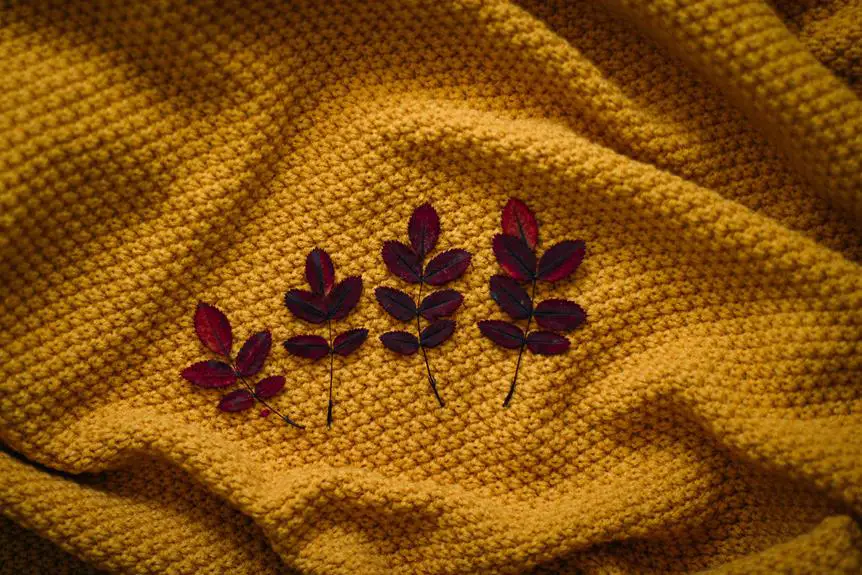Looking to liven up your lackluster sweater? Mastering the art of dyeing can transform your tired threads into vibrant, eye-catching pieces.
In 'How to Dye a Sweater: Top Tips for Vibrant Fabrics,' you'll discover expert techniques to achieve stunning results. From selecting the perfect dye to ensuring an even application, this guide will equip you with the knowledge to breathe new life into your garments.
Whether you're a seasoned dyer or just starting out, these top tips will elevate your skills and bring your sweaters to life with rich, lasting color. Get ready to unleash your creativity and make your wardrobe pop with vibrant hues!
Key Takeaways
- Natural dyes offer an eco-friendly option with soft, muted tones for an organic look.
- Synthetic dyes provide a wide range of vibrant, long-lasting colors and are readily available.
- Pre-wash and dry the sweater to remove residues and conduct a colorfastness test before dyeing.
- Follow specific care instructions to preserve the vibrancy and longevity of the dyed sweater.
Choosing the Right Dye
Have you considered which type of dye works best for your sweater?
When it comes to choosing the right dye for your sweater, you have two main options to consider: natural dyes and synthetic dye options.
Natural dyes, derived from plants, insects, and minerals, offer a more eco-friendly and sustainable choice. They produce soft, muted tones and are perfect for achieving a more organic, earthy look. Some popular natural dye options include indigo, madder root, and turmeric.
On the other hand, synthetic dyes provide a wide range of vibrant, long-lasting colors. They're easier to use and offer a greater variety of shades to choose from. Synthetic dyes are often more colorfast and can withstand repeated washing and exposure to sunlight. They're also readily available in most craft stores and can be used with different types of fibers.
When selecting a dye for your sweater, consider the desired color outcome, the type of fiber your sweater is made of, and the level of environmental impact you're comfortable with.
Preparing the Sweater for Dyeing
Before applying the dye to your sweater, it's crucial to prepare the fabric properly.
First, ensure that you have selected the right dye for the material of your sweater.
Then, pre-wash and dry the sweater to remove any residues that could affect the dye's absorption.
Finally, carefully remove any embellishments or seams that may interfere with the dyeing process.
Following these steps will help you achieve the vibrant, even color you desire for your sweater.
Choosing the Right Dye
To ensure successful dyeing, start by sorting the sweater by color and washing it with a mild detergent to remove any dirt or oils.
When choosing the right dye for your sweater, consider natural dyes such as indigo, madder, or cochineal for a more eco-friendly option. Natural dyes produce unique and beautiful colors, but they may require more effort and time to achieve the desired vibrancy.
On the other hand, synthetic dye options offer a wide range of vibrant colors and are generally easier to use. They can be a great choice for achieving consistent and long-lasting results.
Before selecting a dye, consider the fiber content of your sweater, as different dyes work better with specific fibers.
Always follow the dye manufacturer's instructions for the best results.
Pre-Washing and Drying
When preparing the sweater for dyeing, start by thoroughly pre-washing and drying it to remove any residues that could affect the dyeing process. Use a mild detergent to wash the sweater and avoid using fabric softeners, as they can leave a residue. This pre-dye treatment is crucial to ensure that the dye adheres evenly to the fabric, resulting in vibrant and long-lasting color.
After washing, allow the sweater to air dry completely. Avoid using dryer sheets or fabric softeners in the drying process as well. Once the sweater is dry, conduct a colorfastness test by dampening a small, inconspicuous area and pressing a white cloth against it to check for any color transfer. This step ensures that the sweater is ready to take on the dye effectively.
Removing Embellishments and Seams
Before you begin dyeing your sweater, carefully remove any embellishments and seams using a seam ripper and small scissors. This step is crucial to ensure that the dye can penetrate the fabric evenly and that the embellishments don't interfere with the dyeing process. Here are some top tips for removing embellishments and preserving seams:
- Use a seam ripper to gently detach any decorative elements such as beads, sequins, or patches.
- Carefully cut and remove any visible threads or stitches holding the embellishments in place.
- Take extra care around delicate fabrics to avoid tearing or damaging the sweater.
- Use small scissors to trim any excess fabric or threads around the seams for a clean dyeing surface.
- Inspect the sweater thoroughly to ensure all embellishments and seams are removed before proceeding with the dyeing process.
Applying the Dye Evenly
For even dye application, ensure the sweater's fabric is thoroughly saturated with the dye mixture. This is crucial for achieving vibrant and uniform color penetration.
Start by preparing a dye mixture according to the manufacturer's instructions, ensuring it's well-dissolved.
Submerge the sweater completely in the dye, using a stirring stick to gently agitate the fabric and promote dye absorption. It's important to continuously move the sweater around in the dye bath to prevent any uneven distribution of color.
Pay close attention to areas like seams and cuffs, making sure they receive adequate exposure to the dye. If you're using a hand-dyeing method, massage the dye into the fabric to ensure even coverage.
Additionally, periodically check the saturation level of the fabric to maintain consistency.
Allow the sweater to soak for the recommended time, periodically agitating it to promote dye absorption.
Following these steps will help you achieve an evenly dyed sweater with vibrant and long-lasting color.
Setting the Dye
To set the dye and ensure long-lasting color, carefully follow the manufacturer's instructions for heat or chemical setting methods. Setting the dye is crucial for fixing unevenness and ensuring color fastness.
Here are some top tips to help you set the dye on your sweater:
- Heat Setting: If the dye requires heat setting, use an iron or a clothes dryer as per the manufacturer's instructions. Ensure that the heat setting process is done thoroughly and evenly to prevent color fading or bleeding.
- Chemical Setting: For dyes that require a chemical setting, follow the recommended method provided by the manufacturer. Be meticulous in measuring and mixing the chemicals to achieve the best possible color fastness.
- Rinse Thoroughly: After the initial dyeing process, make sure to rinse the sweater thoroughly to remove any excess dye. This will help in preventing color bleeding and ensure that the dye is set properly.
- Test for Color Fastness: Before wearing or washing the dyed sweater, perform a color fastness test to ensure that the dye has been set effectively. This will help in preventing color transfer onto other garments.
- Follow Care Instructions: Once the dye is set, carefully follow the care instructions provided by the manufacturer to maintain the vibrancy and longevity of the dyed sweater.
Caring for the Dyed Sweater
After setting the dye on your sweater, it's essential to carefully follow specific care instructions to maintain the vibrancy and longevity of the color. Proper caring for your dyed sweater is crucial for preserving the beautiful results of the dyeing process.
To ensure the color maintenance and fabric care, always read and adhere to the care label on your sweater. This may include instructions for washing, drying, and ironing. When washing your dyed sweater, use a gentle detergent and cold water to prevent color fading. Additionally, it's advisable to wash the sweater separately to avoid potential color bleeding onto other garments.
When drying, lay the sweater flat to maintain its shape and prevent stretching. Avoid hanging it, as this can cause the fabric to lose its shape. Furthermore, keep your dyed sweater away from direct sunlight when drying to prevent color fading.
Troubleshooting Common Dyeing Issues
Experiencing issues with dyeing your sweater can be frustrating, but there are solutions to common problems that can help you achieve the vibrant results you desire.
From preventing color blotching to ensuring an even color distribution, troubleshooting dyeing issues is essential for a successful outcome.
Color Blotching Prevention
When dyeing a sweater, be mindful of color blotching to achieve vibrant and even results. Preventing splotchy results and mastering color blending techniques are essential for a successful dyeing process.
To avoid color blotching, consider the following tips:
- Pre-soak the sweater in a solution of water and vinegar to help the fabric absorb the dye evenly.
- Use a large, non-reactive container to allow the sweater to move freely in the dye bath.
- Stir the sweater continuously in the dye bath to ensure the color penetrates evenly.
- Add the dye gradually and in small increments to control the color saturation and prevent blotching.
- Rinse the sweater thoroughly with cold water to remove excess dye and prevent uneven color distribution.
Achieving Even Color
To achieve even color when dyeing your sweater, it's important to carefully monitor the dyeing process and make adjustments as needed.
One common issue that can lead to uneven color is inadequate dye saturation. Ensure that the sweater is fully submerged in the dye bath and agitate it regularly to promote even color blending.
Additionally, be mindful of the dye concentration and follow the manufacturer's instructions to achieve the desired color intensity.
If you're dyeing a large sweater or multiple garments, consider using a larger dye bath to prevent crowding, which can result in uneven dyeing.
Lastly, maintaining a consistent water temperature throughout the dyeing process is crucial for achieving uniform color.
Fixing Uneven Dyeing
Are you wondering how to rectify uneven dyeing and troubleshoot common issues that may arise during the dyeing process? Fixing uneven dyeing can be challenging, but with the right techniques, you can salvage your garment. Here are some tips to help you address this issue:
- Color blending techniques: Utilize color blending methods to blend different shades and create a more uniform appearance.
- Spot dyeing methods: Apply dye only to the areas that appear lighter to even out the color.
- Retouching with a brush: Use a small brush to touch up lighter areas with a slightly stronger dye solution.
- Bleaching and redyeing: If the color is drastically uneven, consider bleaching the garment and redyeing it to achieve a more consistent shade.
- Professional help: If all else fails, seek assistance from a professional dyeing service to salvage the garment.
Frequently Asked Questions
Can I Use Natural Dyes Like Beet Juice or Turmeric to Dye My Sweater?
You can use natural dye alternatives like beet juice or turmeric to dye your sweater. However, synthetic dyes generally offer better colorfastness. Make sure to prepare the fabric properly for optimal results.
How Do I Prevent the Dye From Bleeding Onto Other Clothes When I Wash the Sweater?
To prevent bleeding when washing your dyed sweater, prioritize color fastness. Use cold water and a gentle detergent to wash, and avoid mixing with other clothes. Always follow the specific fabric care instructions for best results.
Can I Dye a Sweater That Is a Blend of Different Fabrics, Such as Wool and Acrylic?
Yes, you can dye a sweater that is a blend of different fabrics, such as wool and acrylic. Blending techniques and color mixing are essential for achieving vibrant results while ensuring colorfastness during the dyeing process.
Is It Safe to Use a Microwave to Set the Dye on My Sweater?
Yes, it's safe to use a microwave to set the dye on your sweater, but be cautious. Microwaves can affect color fastness and fabric compatibility. Make sure to follow proper dyeing techniques and test for microwave safety.
Can I Dye a Sweater That Already Has a Pattern or Design on It?
Yes, you can dye a patterned sweater, but it requires careful consideration of dyeing techniques and color fastness. Fabric patterns present dyeing challenges, so ensure proper preparation and use appropriate dye to achieve vibrant results.
- Recycling Nonwoven Fabrics: Is It Possible? - July 11, 2025
- Recycling Nonwoven Fabrics: Is It Possible? - July 11, 2025
- Recycling Nonwoven Fabrics: Is It Possible? - July 11, 2025







